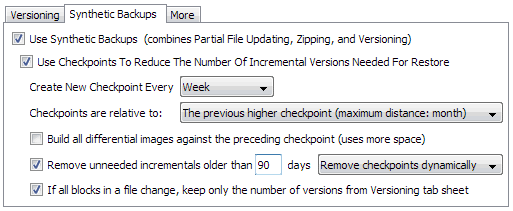Synthetic Backup is the combination of Block Level Copying (formerly called Partial File Updating) with Versioning, Filename Encoding and Compression. It can be used with any backup storage location, including FTP and other Internet Protocols. The compressed files can be encrypted. Synthetic Backup can be described as Differential Versioning.
Like Block Level Copying, it is only appropriate for a few types of files: large databases, Outlook PST files, and VM disk images. Rather than backing up the complete files every time, it will put the changed blocks in separate zip or sz files. Stream-based files such as Office documents, zip files, PDF files, and images will not benefit from Synthetic Backup.
Checkbox to choose:
– tab sheet Versioning->Synthetic Backups: “Use Synthetic Backups”
The following dependent options are then checked automatically:
– tab sheet Special: “Block Level Copying” (without Remote Service)
– tab sheet Zipping: “Compress Each File Individually”
– tab sheet Versioning: “Filename Encoding”
All incremental versions must be kept in the same folder.
Be sure to keep all incremental files on the destination as they may all be needed to reassemble the
file upon restore. However, the number of older incremental parts that need to remain on the
backup storage can be limited thru the “Checkpoint” feature. You will find its settings
on the tab sheet Versioning->Synthetic Backup:

A checkpoint is an incremental backup just like the daily backups. However, it is a little larger because it includes the changed blocks of a longer period of time, so that many preceding incrementals become unnecessary.
Any older version can be restored by choosing the desired target date in the Restore Wizard, or by right-clicking the file in the Sync Preview and choosing the desired version. The option “Keep multiple files” is implied and does not need to be checked. It cannot be used to limit the number of older versions. However, if this option is specified on the Versioning tab sheet, it will be used as a minimum number of versions to keep even if the Checkpoints feature would allow to keep fewer versions.
A restore of the synthetic backup files can be done independently from the original job, to any destination. No database is needed for the restore – just the files.
The minimum file size for Synthetic Backup can be specified on the tab sheet “Types, Limit” on the Program Settings dialog. The granularity of the differential backup is determined dynamically for each file, based on its size. The smallest block size used will be 2048 bytes.
Each partial backup includes an MD5 checksum for each file, so that restored files can be verified to be 100% correct. You can see this in the file MD5.TXT that the partial zips contain.
The Zip or Sz file sizes can be limited too so that large files can be split (only in conjunction with Block Level Copying). The transfer can be stopped any time and zip or sz parts already uploaded won’t be lost.
Since every backup contains only the changed blocks, you would theoretically need all of the backup files to restore the complete file, because every backup file contains different blocks. To reduce the number of files that a successful restore will depend on, you can use checkpoints. The checkpoints are like regular backup files, but they contain more blocks than just the ones changed since the previous backup. For example, the first weekly checkpoint in a month could contain all the blocks changed in the previous month. So for a restore, you would only need the monthly backup files plus the most recent weekly ones plus the most recent daily ones.
Because a quarterly checkpoint relative to the previous quarter can be quite large (because it contains all the changed blocks since the previous quarter), you can limit the distance that a checkpoint is based on to a month or even a week.
How the checkpoints depend on each other has an influence on how many small, older backup files can be purged.
